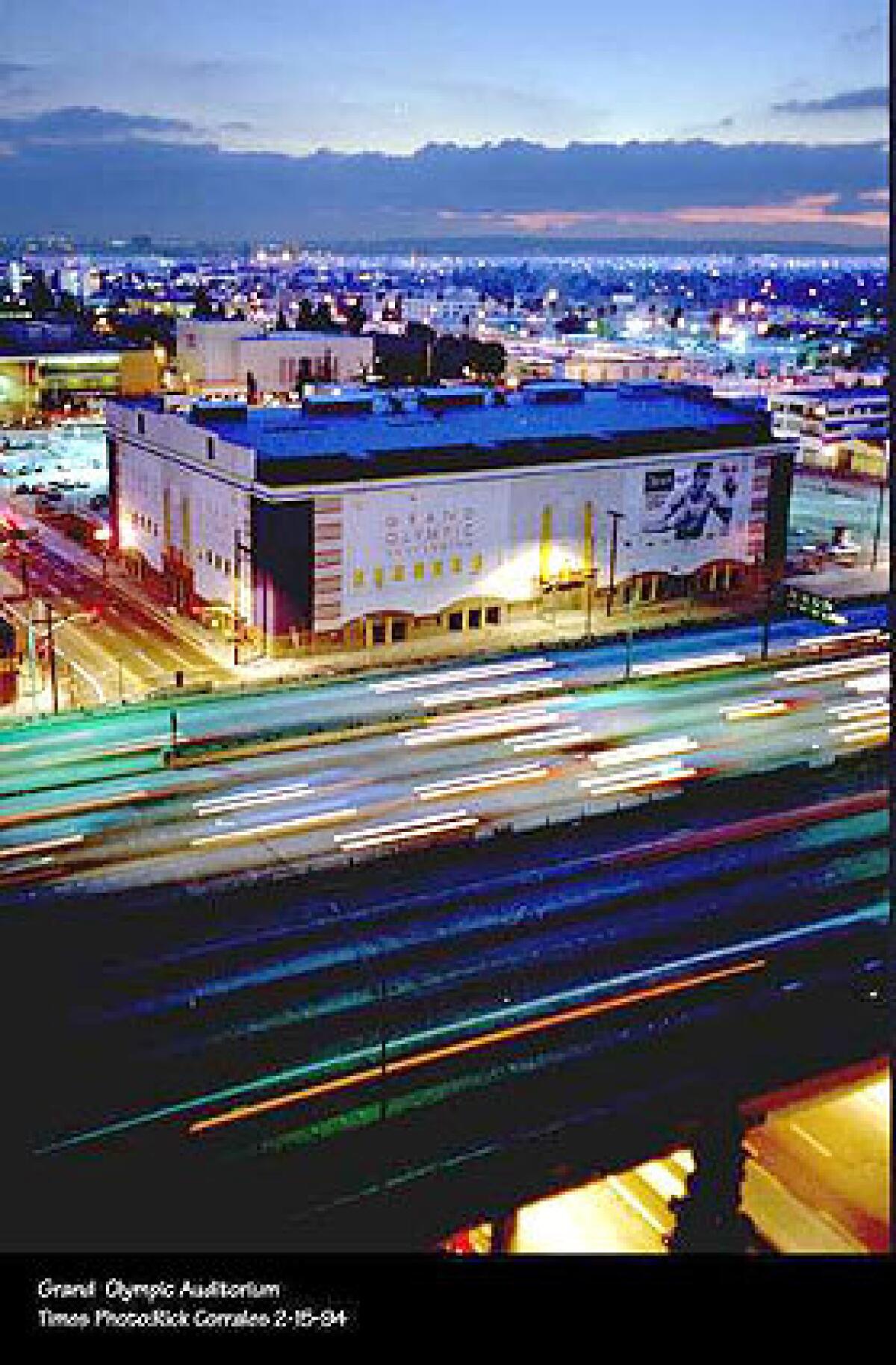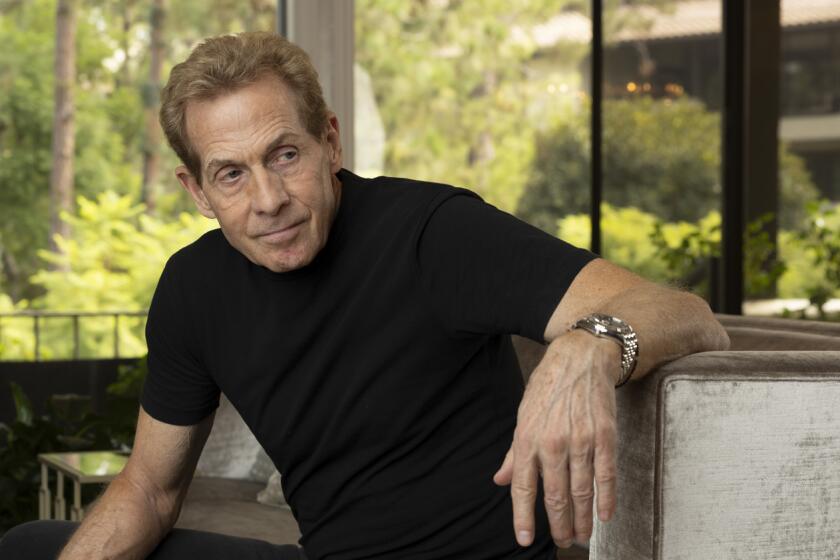This City Was Full of Fight

Los Angeles boxing mecca opened in 1925 on the corner of 18th and Grand, and attracted such names as Mae West, Al Jolson and later Robert Taylor and Barbara Stanwyck. This photo shows a crowd on hand for a 1974 bout.
FOR America’s big-league sports, L.A. was a distant outpost for the first half of the 20th century, impressive for an off-season vacation, impractical as a home base. Before jet travel, any team moving to the West Coast would have presented a scheduling nightmare.
The Rams, who played only once a week, were the first to make the leap, coming in the 1940s. The Dodgers followed in the late 1950s, the Lakers not until 1960.
But boxing was different. Unencumbered by the need to regularly transport a full team a thousand miles or more, boxing found its way here even before the start of the last century.
James Jeffries, who won the heavyweight title from Bob Fitzsimmons in 1899, began his professional career in his hometown, Los Angeles, where he knocked out Hank Griffin in 14 rounds in 1896.
Jack Johnson, before he beat Tommy Burns for the heavyweight title in 1908, won the black heavyweight championship five years earlier by defeating Denver Ed Martin in 20 rounds in L. A. in 1903.
Over the ensuing century, this city produced one favorite son after another in the ring: Henry Armstrong, Art Aragon, Jerry Quarry and Schoolboy Bobby Chacon.
In the last 15 years, three of the sport’s most recognizable figures have emerged from this area: Oscar De La Hoya from East Los Angeles, Shane Mosley from Pomona and Fernando Vargas from Oxnard. Three others — heavyweights James Toney, and Vitali and Wladimir Klitschko — moved here with the hope this would be a launching pad for the top of the heavyweight division.
But although they all lived here, they rarely fought here after their marketability grew. Instead, they followed the money. And except for an occasional championship match at Staples Center, that has meant fighting in Las Vegas. Since the Olympic Auditorium and the Forum went dark in the last decade, in terms of regularly scheduled matches, there has been no major venue for a promising fighter to polish his skills as he moved from club fighter to headliner.
It was far different a century ago.
The city of Vernon was the first focal point for the sport in the Los Angeles area, thanks to a bartender and former railroad worker named Jack Doyle, who opened a training camp in Arcadia in 1908, according to the Tacoma News-Tribune.
Two years later, when he opened a bar in Vernon, Doyle decided boxing would be a great vehicle for getting customers into his establishment. So he began to stage four-round fights, the participants lined up by matchmaker Wad Wadhams.
The fights were held in the indoor Vernon Arena. Another local promoter, Uncle Tom McCarey, built an outdoor Vernon Arena.
By 1914, the state had put strict regulations on the sport. Fights were limited to four rounds, purses to $25.
Fights were also held in the Wilmington Bowl, fighters often training for area matches in Venice and San Pedro.
In the early 1920s, Doyle built a 7,000-seat arena in Vernon, but its popularity was short-lived. On Aug. 4, 1925, L.A.’s boxing mecca, the Olympic Auditorium, opened on the corner of 18th and Grand.
“The Auditorium blazed with glory on its opening night,” according to an article the next day in The Times, “the light of many electric lights surpassed only by the sparkling jewels that adorned the persons of several of our well-known citizens and citizenesses. Hollywood and the moving picture colony slipped into their tuxedos and formal apparel and blessed the ringside by their presence.”
In the early days of the Olympic, Mae West, Lupe Velez, Ruby Keeler, Al Jolson and later Robert Taylor and Barbara Stanwyck could be found in the good seats.
By the middle of the last century, a fight fan could be entertained all week without leaving the area. Ocean Park Arena in Santa Monica had fights on Tuesdays, the Olympic on Thursdays and Hollywood Legion Stadium on Saturdays.
And the famous and the infamous tagged along, especially at Hollywood Legion Stadium, where entertainers Bob Hope, Frank Sinatra, Jolson, Eddie Cantor and George Raft rubbed elbows with mobsters such as Mickey Cohen.
Armstrong, who moved to Los Angeles as an amateur boxer, would be at the top of the list of L.A.’s best fighters, pound for pound, and certainly near the top of any list.
In the days when there was only one champion in each weight division, Armstrong won the featherweight, welterweight and lightweight titles in 1937 and ’38.
And he almost added a fourth belt to his expanding frame, fighting Ceferino Garcia to a draw in a middleweight title match at Gilmore Field in 1940.
If Armstrong was the most talented L.A. fighter, Art Aragon was the most colorful.
Aragon, who fought from 1944 to 1960, was “the Golden Boy” long before De La Hoya was born, so-named by actor William Holden, who had starred in the movie “The Golden Boy.” Said Holden, pointing to Aragon: “Here’s the real Golden Boy.”
Aragon (89-20-5, 59 knockouts), a lightweight, never won a title, but he sure won over the fans, packing arenas for his often brutal, usually entertaining fights.
And he won over the media as well with his one-liners. Describing a fight he’d lost after dieting to make weight, he said, “I was the only fighter who ever had to be carried into the ring.”
Among L.A.’s most memorable matches:
The welterweight title fight between Joe Rivers, known as “the Lethal Latin,” and Ad Wolgast at Vernon Arena in 1912. They went down from simultaneous punches in the 13th round for a double knockout. The victory was awarded to Wolgast, the defending champion.
The welterweight title fight in which Jimmy McLarnin beat Young Corbett III in 1933 in front of 15,000 at Los Angeles’ Wrigley Field.
The featherweight match between Chacon and Danny “Little Red” Lopez that drew 16,080 to the Sports Arena in 1974, with an additional 2,671 paying to watch the fight on closed-circuit television at Olympic Auditorium. Chacon won on a ninth-round TKO.
Muhammad Ali fought three times at the Sports Arena as Cassius Clay, the last time against Archie Moore in 1962, winning all three matches. He returned as Ali to beat Ken Norton in 1973 at the Forum.
There were also many colorful L.A. figures outside the ring among promoters and matchmakers, from Aileen Eaton and George Parnassus to Mickey Davies, Babe McCoy and Don Chargin.
Staples Center is trying to write its own chapter in the city’s rich boxing history.
It was the site of the first De La Hoya-Mosley fight in 2000. Roy Jones, Bernard Hopkins and Lennox Lewis have also fought there.
And on April 24, 2004, Vitali Klitschko beat Corrie Sanders at Staples to win the World Boxing Council heavyweight championship.
Klitschko has since retired, moved back to Ukraine and recently announced his candidacy for mayor of Kiev.
L.A.’s last heavyweight champion, Jeffries, won his title in 1899. Only boxing, of all of L.A.’s sports, can measure its monumental moments by the century.
More to Read
Go beyond the scoreboard
Get the latest on L.A.'s teams in the daily Sports Report newsletter.
You may occasionally receive promotional content from the Los Angeles Times.










